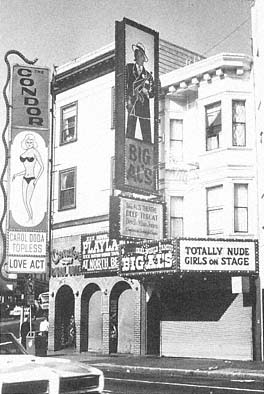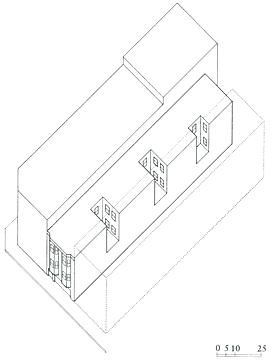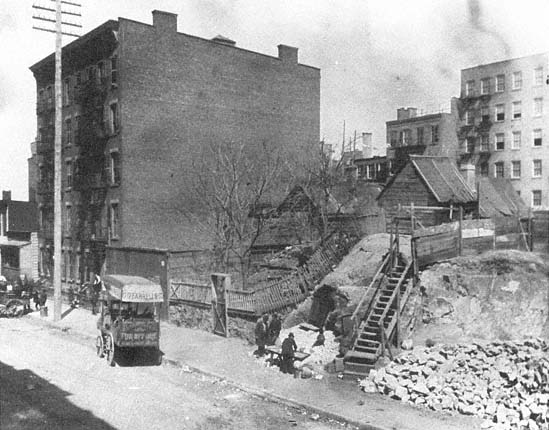Cultural Invisibility
Hotel residents and buildings are real enough, but they stubbornly remain outside of public awareness. Not surprisingly, two of the path-breaking books of the 1970s on SROs have the words "unseen" and "invisible" in their titles.[34] Early in the fight to make hotel life better understood, a St. Louis observer, Ira Ehrlich, summarized the problem in direct terms:
Single room occupants are omitted in the language of housing legislation, written off in the minds of communities, ignored and rejected in urban development plans, and pushed from one area to another on the waves of fluctuating real estate markets.[35]
More recently a San Francisco architect and scholar, John Liu, has written that "the Single Room Occupancy (SRO) residential hotel is perhaps the most controversial, the most neglected, and the least understood of all housing types."[36]
Hotel lives are culturally invisible in part because the public is disinterested and ignorant about any housing needs of the poor. Cushing Dolbeare, a founder and longtime executive director of the National Coalition for Low-Income Housing, complains, "As a problem, housing often eludes our grasp. It does not gain the political constituency it deserves. Other than homelessness, housing needs are simply not visible to most Americans."[37] Another barrier to understanding hotel life is based on the fact that so many hotel people are single and have developed social orders strongly differing from those in traditional American family units. Housing needs for single people—twenty-five years of age or fifty-five years of age—are rarely discussed even by housing experts. One of the path-breaking New York hotel activists, Carroll Kowal, writes that "federal housing policy deals with the population it is comfortable with: the family. Housing authorities have no understanding of non-family persons," let alone living units with no kitchens and a bath down the hall.[38] The numbers of single people tend to be underestimated throughout our society, even though they have always been an important share of the American adult population. In 1980, America had about 50 million married households and 21 million people living alone.[39]
Small hotels, which can make up half of a city's residential hotel stock, are easy to miss because the hotel rooms are usually on second and third floors above retail shops. Signs left from the 1920s feebly

Figure 1.8
The corner of Broadway and Columbus Avenue
in San Francisco's North Beach neighborhood
in 1985. Between Big Al's and the Condor Club
is the small street entrance to the residential
hotel above Big Al's.

Figure 1.9
Isometric drawing of the Sierra House, the rooming
house above Big Al's North Beach nightclub.
announce the upstairs hotel functions while public attention is distracted by the signs and show windows of stores, restaurants, and nightclubs. In San Francisco's North Beach entertainment district, Carol Doda's sign and club at Broadway and Columbus were wellknown landmarks to tourists and residents (fig. 1.8). Yet within three hundred feet of that sign, on the second and third floors of the buildings, are over three hundred hotel homes (fig. 1.9).[40] Virtually no one passing on Broadway thinks about those seventy-year-old dwellings, or who lives in them.
More expensive hotel life is hard to see as well. Travelers in expensive hotels assume everyone else is a transient guest, too. Old buildings with names like the Barrington prompt the belief that they have always been apartment buildings when, in fact, they were originally hotels. At a public meeting in 1981, Melvin Carriere, a vice president in San Francisco's Wells Fargo Bank, confessed that he had never heard of a residential hotel or the notion of living in one until a community group asked for a hotel loan. He had been passing residential hotels every day

Figure 1.10
The unfinished city. Jacob Riis's photograph of small wooden shacks next to a brick tenement
in Hell's Kitchen in New York City emphasized the problems of old city rules.
on his way to work but had never noticed them. "I couldn't believe people wanted to live in a hotel," he added.[41]
Another barrier to understanding hotels is revealed when writers persist in labeling all people who live in hotels or motels as "homeless." The horrors of New York's welfare hotels or the squalor of a Los Angeles residential motel frequently matches the worst of homeless conditions. But if not overcrowded, a good hotel room of 150 square feet—dry space, perhaps with a bath or a room sink, cold and sometimes hot water, enough electric service to run a 60-watt bulb and a television, central heat, and access to telephones and other services—constitutes a living unit mechanically more luxuriant than those lived in by a third to a half of the population of the earth. As Dolores Hayden reminds us, many of the world's people would consider an American two-car garage an excellent dwelling in its own right.[42] The urban Americans living in hotels are not homeless. They are living in admittedly minimal and unusual dwelling units, often in hideous re-
pair and under woefully inadequate management but dwelling units nonetheless. Calling SRO people homeless reinvokes the cultural bias against hotel life. In the long run, the ecologically and culturally aberrant idea about housing may prove to be the huge single-family house on an open lot, not the more social way of living downtown in a hotel.
Other barriers to appreciating hotels have to do with the different notions people have about the ideal city. Supporters of hotels and those who see them as perverse ghettos hold deeply rooted and opposing conceptions about the proper rules for building urban space. The old city view stems from centuries-old European mercantile cities that had an urbane, densely congregated way of living with mixed income groups, adjacencies of housing, commerce, and workshops, all in buildings that crowded their lots and the street, with very little guarantee of permanence or a finished state (fig. 1.10). Downtown American hotel districts are a holdover of old city life.
After 1880, visionary experts and commercial leaders in America worked feverishly on building a new kind of city. Faced with the social and physical problems of industrialization in cities, directed by the needs and values of business elites, and reinforced by discoveries in public health, reformers consciously rejected the building and land-use rules of the old city. Beginning in large new suburbs, in vast industrial works, and in monumental architectural projects downtown, reformers and property developers embraced a modern set of architectural rules built around separation and specialization. The new rules promised each function in an area by itself, uniformity within areas, less mixture of social classes, maximum privacy for each family, much lower density for many activities, buildings set back from the street, and a permanently built order (fig. 1.11). By the 1890s, new city ideas had begun to be popular, particularly among the middle and upper class. Promoters of the new city planned for hotel living to be a deliberate casualty of the transition between the old city and the new city. Thus, as early as the 1890s, hotels had begun to be forbidden housing; their residents, forbidden citizens. These tensions between ideals were particularly clear in rapidly growing new cities.